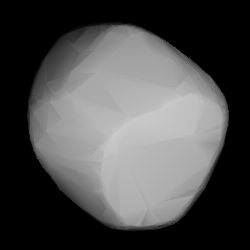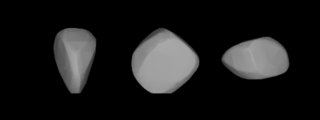Related Research Articles

1388 Aphrodite is an asteroid of the Eos family from the outer regions of the asteroid belt, approximately 22 kilometers in diameter. It was discovered on 24 September 1935, by Belgian astronomer Eugène Delporte at the Royal Observatory of Belgium in Uccle. The likely elongated K-type asteroid has a rotation period of 11.9 hours. It was named after the Greek goddess Aphrodite from Greek mythology.
1099 Figneria, provisional designation 1928 RQ, is an asteroid from the background population of the outer regions of the asteroid belt, approximately 26 kilometers in diameter. Discovered by Grigory Neujmin at Simeiz Observatory in 1928, the asteroid was later named after Russian revolutionary activist Vera Figner.
1122 Neith, provisional designation 1928 SB, is a background asteroid from the central region of the asteroid belt, approximately 12 kilometers in diameter. It was discovered by Belgian astronomer Eugène Delporte at the Royal Observatory of Belgium in Uccle on 17 September 1928. The asteroid was named after the goddess Neith from Egyptian mythology.
12696 Camus, provisional designation 1989 SF1, is a carbonaceous background asteroid from the central region of the asteroid belt, approximately 9 kilometers in diameter.
1194 Aletta, provisional designation 1931 JG, is a carbonaceous asteroid from the outer region of the asteroid belt, approximately 55 kilometers in diameter. It was discovered on 13 May 1931, by South African astronomer Cyril Jackson at Johannesburg Observatory in South Africa. It was later named after the discoverer's wife Aletta Jackson.
3567 Alvema, provisional designation 1930 VD, is a dark asteroid from the middle region of the asteroid belt, approximately 14 kilometers in diameter. It was discovered by Belgian astronomer Eugène Delporte at the Royal Observatory of Belgium in Uccle, on 15 November 1930. It was named after the discoverer's three great-granddaughters Aline, Vérionique and Martine.
1240 Centenaria, provisional designation 1932 CD, is a background asteroid from the outer regions of the asteroid belt, approximately 60 kilometers in diameter. It was discovered on 5 February 1932, by astronomer Richard Schorr at the Bergedorf Observatory in Hamburg, Germany. The assumed C-type asteroid has a rotation period of 11.3 hours. It was named for the 100th anniversary of the discovering observatory.

1244 Deira is a dark background asteroid and slow rotator from the inner region of the asteroid belt. The X-type asteroid has an exceptionally long rotation period of 210.6 hours and measures approximately 31 kilometers in diameter. It was discovered on 25 May 1932, by English-born South African astronomer Cyril Jackson at the Union Observatory in Johannesburg, who named it after Deira, an old kingdom near his birthplace, the market town of Ossett, located in West Yorkshire, England.
1710 Gothard, provisional designation 1941 UF, is a stony asteroid from the inner regions of the asteroid belt, approximately 9 kilometers in diameter. It was discovered on 20 October 1941, by Hungarian astronomer György Kulin at the Konkoly Observatory in Budapest, Hungary. It was later named after Hungarian amateur astronomer Jenő Gothard.

1251 Hedera is a background asteroid from the central regions of the asteroid belt, approximately 13 kilometers in diameter. It was discovered on 25 January 1933, by German astronomer Karl Reinmuth at the Heidelberg-Königstuhl State Observatory in southwest Germany. The asteroid was named for the climbing plant Hedera, commonly known as "ivy".
5333 Kanaya, provisional designation 1990 UH, is a carbonaceous asteroid from the inner regions of the asteroid belt, approximately 14 kilometers in diameter.

1836 Komarov is a carbonaceous Dorian asteroid from the central region of the asteroid belt, approximately 22 kilometers in diameter. It was discovered on 26 July 1971 by Russian astronomer Nikolai Chernykh at Crimean Astrophysical Observatory in Nauchnij on the Crimean peninsula. It was named after Soviet cosmonaut Vladimir Komarov.

1607 Mavis, provisional designation 1950 RA, is a stony asteroid from the central region of the asteroid belt, approximately 12 kilometers in diameter. It was discovered on 3 September 1950, by South African astronomer Ernest Johnson at Johannesburg Observatory in South Africa. It was later named after the wife of astronomer Jacobus Bruwer.
6615 Plutarchos, provisional designation 9512 P-L, is a Florian asteroid and suspected binary from the inner regions of the asteroid belt, approximately 3.1 kilometers in diameter. Discovered during the Palomar–Leiden survey in 1960, the asteroid was later named after the Greek philosopher Plutarch. Its minor-planet moon was discovered in 2007.
1979 Sakharov, provisionally designated 2006 P-L, is a stony Vestian asteroid from the inner regions of the asteroid belt, approximately 4.5 kilometers in diameter. It was discovered during the Palomar–Leiden survey in 1960, and named after Russian physicist Andrei Sakharov.
13006 Schwaar, provisional designation 1983 AC1, is a stony Phocaea asteroid from the inner regions of the asteroid belt, approximately 5 kilometers in diameter. It was discovered on 12 January 1983, by American astronomer Brian Skiff at Lowell's Anderson Mesa Station in Flagstaff, Arizona. The asteroid was named after amateur astronomer Pierre–Yves Schwaar.

1449 Virtanen, provisional designation 1938 DO, is a stony Florian asteroid from the inner regions of the asteroid belt, approximately 9.2 kilometers in diameter. It was discovered on 20 February 1938, by Finnish astronomer Yrjö Väisälä at Turku Observatory in Southwest Finland, and named for Finnish biochemist Artturi Virtanen.
6181 Bobweber, provisional designation 1986 RW, is a stony asteroid from the inner regions of the asteroid belt, approximately 5 kilometers in diameter. It was discovered on 6 September 1986, by American astronomer Eleanor Helin at the U.S. Palomar Observatory in California, and named after astronomer Robert Weber.
(6265) 1985 TW3 (provisional designation 1985 TW3) is a background asteroid and binary system from the inner regions of the asteroid belt. It was discovered on 11 October 1985, by astronomer by T. F. Fric and Richard Gilbrech at the Palomar Observatory in California. It is the only minor-planet discovery for these two astronomers. The stony L-type asteroid measures approximately 5 kilometers (3.1 miles) in diameter and has a rotation period of 2.7 hours. Its 1.2-kilometer sized minor-planet moon was discovered in July 2007 and announced the following month.
10208 Germanicus, provisional designation 1997 QN1, is a stony Florian asteroid and binary system from the inner regions of the asteroid belt, approximately 3.5 kilometers in diameter.
References
- 1 2 3 4 "JPL Small-Body Database Browser: 4904 Makio (1989 WZ)" (2017-06-05 last obs.). Jet Propulsion Laboratory . Retrieved 20 June 2017.
- 1 2 3 Schmadel, Lutz D. (2007). "(4904) Makio". Dictionary of Minor Planet Names – (4904) Makio. Springer Berlin Heidelberg. p. 423. doi:10.1007/978-3-540-29925-7_4794. ISBN 978-3-540-00238-3.
- 1 2 3 "4904 Makio (1989 WZ)". Minor Planet Center. Retrieved 18 November 2016.
- 1 2 3 4 5 6 7 "LCDB Data for (4904) Makio". Asteroid Lightcurve Database (LCDB). Retrieved 18 November 2016.
- 1 2 3 4 Mainzer, A.; Grav, T.; Masiero, J.; Hand, E.; Bauer, J.; Tholen, D.; et al. (November 2011). "NEOWISE Studies of Spectrophotometrically Classified Asteroids: Preliminary Results". The Astrophysical Journal. 741 (2): 25. arXiv: 1109.6407 . Bibcode:2011ApJ...741...90M. doi:10.1088/0004-637X/741/2/90.
- 1 2 3 Masiero, Joseph R.; Mainzer, A. K.; Grav, T.; Bauer, J. M.; Cutri, R. M.; Dailey, J.; et al. (November 2011). "Main Belt Asteroids with WISE/NEOWISE. I. Preliminary Albedos and Diameters". The Astrophysical Journal. 741 (2): 20. arXiv: 1109.4096 . Bibcode:2011ApJ...741...68M. doi:10.1088/0004-637X/741/2/68 . Retrieved 5 December 2016.
- 1 2 Oey, Julian (October 2010). "Light Curve Analysis of Asteroids from Leura and Kingsgrove Observatory in the First Half of 2009". The Minor Planet Bulletin. 37 (4): 135–136. Bibcode:2010MPBu...37..135O. ISSN 1052-8091 . Retrieved 18 November 2016.
- ↑ Veres, Peter; Jedicke, Robert; Fitzsimmons, Alan; Denneau, Larry; Granvik, Mikael; Bolin, Bryce; et al. (November 2015). "Absolute magnitudes and slope parameters for 250,000 asteroids observed by Pan-STARRS PS1 - Preliminary results". Icarus. 261: 34–47. arXiv: 1506.00762 . Bibcode:2015Icar..261...34V. doi:10.1016/j.icarus.2015.08.007 . Retrieved 18 November 2016.
- ↑ "MPC/MPO/MPS Archive". Minor Planet Center. Retrieved 18 November 2016.